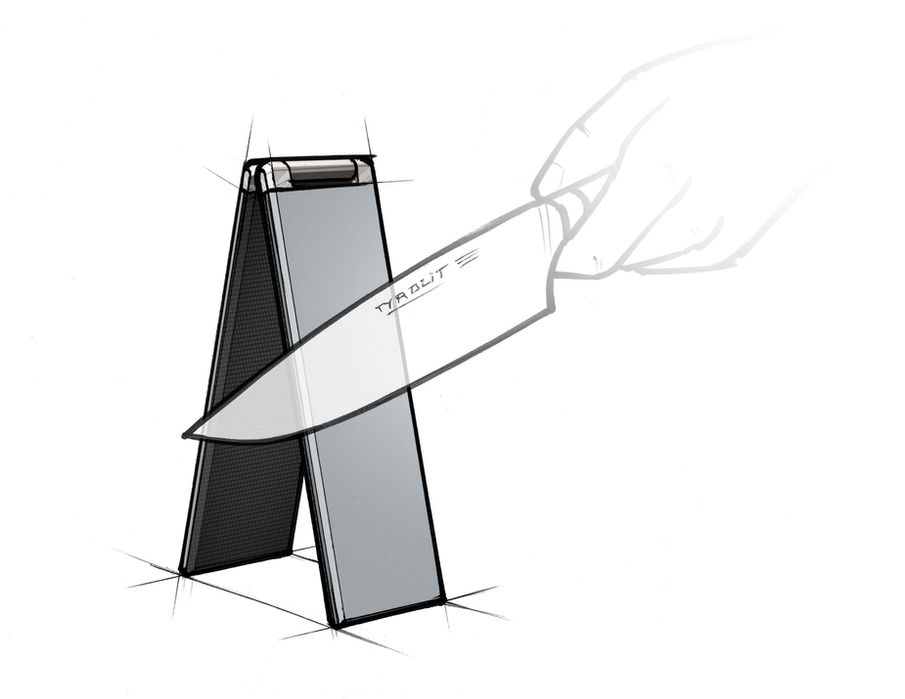top of page
SOLO PROJECT
TIMELINE: 2 DAYS
This is a 2-day project - an accelerated product conceptualization meant to show raw process. The brief is to design a portable knife sharpening product that integrates into the TYROLIT LIFE portfolio, a premium brand that sells mainly knives, statement piece kitchenware and abrasive products. Focus was on process, thought, and analog sketching skills. This project outline is meant to help you better understand the way I work and think. Enjoy!
Design process:
Portable knife sharpening

Project brief overview and game plan.
Every project I do starts with notes on the brief. This helps digest the project as a whole and keeps from missing details along the way. After the brief comes a game plan divided into phases:
Phase 1: TYROLIT LIFE Brand Research
Phase 2: Market Research
Phase 3: Broad Ideation
Phase 4: Targeted Ideation
Phase 5: Refinement
Phase 1: TYROLIT LIFE Brand Research
Analyzing their website, digesting the visual brand language, discovering their product offerings, colors, materials, and key words.
Cutting products.
< SCROLL >
Sharpening Products.
< SCROLL >
TYROLIT LIFE sharpening products use the 15 degree optimal angle as the foundation for their designs. These products claim to offer professional sharpening results with minimal effort and skill, however there is one inconvenience worth noting:
Pain Point: Sharpening both sides of the knife.
You must rotate the entire product in order to sharpen both sides of the knife with the same stone. If you are cycling through the different stones in order for each side of the blade, then it is required to rotate the product 2x for the MK2 models and 5x for the three-stone model. When using the compact sharpener with the stone upright, you must rotate the product, flip the stone, then rotate the product again to cycle the through the grits in order.
Miscellaneous products.
< SCROLL >
Brand language, literally.
For each product I pulled out recurring words from their descriptions that seemed to encapsulate the brand. These will be used as inspiration during the ideation phase to drive TYROLIT's brand values into the new concepts.

Materials.
The main materials that are embraced in their product line: stainless steel, stone, wood (light oak & beech), acrylic, micarta, ceramic, leather.
< SCROLL >
Phase 2: Market Research
Discovery of current products in competition and related to portable knife sharpening. The goal here is to avoid designing something that already exists, and to get inspiration from some of the more innovative ideas.

Phase 3: Broad Ideation
The blue sky phase - quick sketches with a focus on quantity of ideas. Sketches are chronological from left to right.
< SCROLL >
Phase 4: Targeted Ideation
Picking one idea from Phase 3 and "fleshing it out". These sketches are more focused on capturing technical design details and thoughts on function, form, usability, and experience.
The chosen concept was the folding set-angle stones (the last sketches in Phase 3). This design would reflect major details of TYROLIT's existing products with the 15 degree angle setup, and the pull-down sharpening technique to which TYROLIT users are trained.
The pull-through concepts with carbide and ceramic sharpening slots would offer improved practicality and speed for use on the go, however this seemed like too far of a departure from TYROLIT's brand fundamentals. Their USP is high quality sharpening stones and proper angles - this theme ultimately drove the concept selection.
< SCROLL >
Hinge details.
At this point it was clear that a reliable hinge needed to be designed. After exploring a number of different options for a 2-way hinge, I found inspiration from the Lenovo Yoga 3 Pro laptop. The hinge folds completely flat in both directions and has a significant resistance to movement (the hinge stays where you put it). Lenovo's design is visually overcomplicated for TYROLIT's brand language, so the next challenge was to redesign and simplify the mechanism.
< SCROLL >
Phase 5: Refinement
Finalizing the idea to form a complete concept.
Design decisions from Phase 4:
-
The stones will be backed with a cover material (light oak & micarta) to protect them while closed. This is not only to keep the stones safe from scratches and dings, but other items as well that may be in the same bag, bucket, or cooler.
-
The hinge will have significant resistance to movement, and have detents that "snap" the hinge into place when it reaches the optimal 15 degree angle.
-
The hinge will be stainless steel to prevent any rusting and relate to TYROLIT's knife products.
-
The product should be offered in various stone combinations: a model with the same stone grit on each side would care to users trying to achieve a quick, even sharpen. A model with different stone grits would care to users who prefer sharpening through multiple grits to achieve a better finish.
The scale of the product was inspired by the standard size of TYROLIT sharpening stones and related objects. Final overall dimensions were 16cm x 5cm x 1.6cm.

Hinge details, again.
In order to make sure that the hinge mechanism was actually possible, I made a quick CAD model of the chamfered hinge. It turns out that there was interference with the chamfer design while opening the hinge, and an alteration was needed. I ended up creating a more rounded hinge design that eliminated any interference and kept the main chamfer of the stone continuous.
Chamfer design with hinge interference:
< SCROLL >
Revised design without hinge interference:
< SCROLL >
Final design.
< SCROLL >
bottom of page


















































































